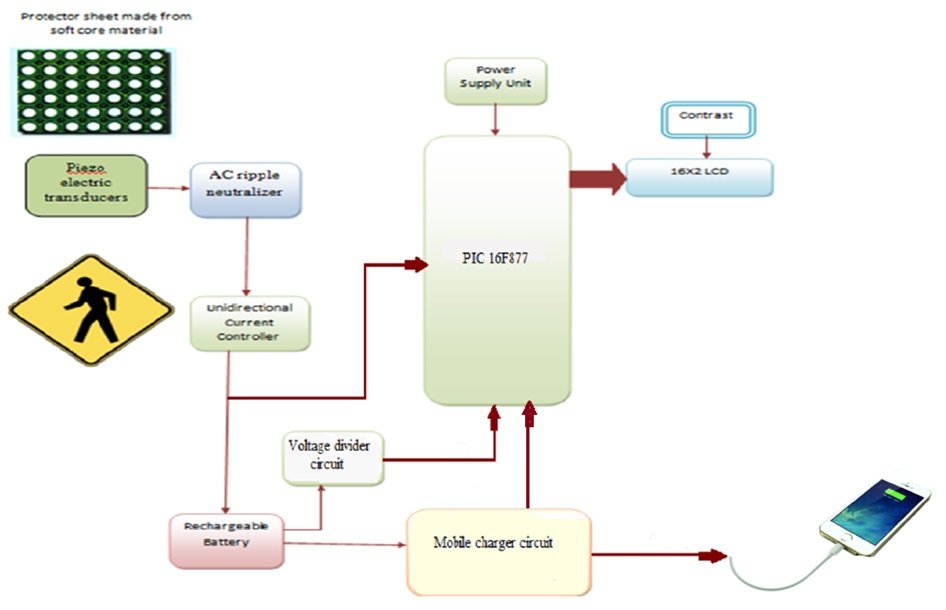Foot step power generation system using pic microcontroller (original) (raw)
Foot step power generation system
In this foot step power generation project is designed to convert foot step, walking and running energy into electrical energy. It is used to generate electricity from by walking or running on foot step. The demand of electrical energy is increasing day by day. But power generation conventional resources are now not enough for total demand of electrical energy. Therefore many researchers and engineers are working on non conventional ways of electrical power generation. Foot step power generation system is also a non conventional electrical energy production system. It converts mechanical energy of foot steps into electrical energy by using transducers. This power generation system can become very popular among populated countries like Pakistan, china, India. It can be implemented on roads, bus stations and many public places. Although this system is little bit expensive, but it can make a huge difference in electrical power generation of country.
Foot step power generation system basically converts force energy of foot into electrical energy by using piezoelectric sensor. Piezoelectric sensor is transducer which converts force energy into electrical energy. I will discuss it in more detail in later part of this article.
Foot step power generation system working
Working of footstep power generation system consists of following main points:
- Piezoelectric sensor interfaced with microcontroller and used as a transducer to convert force energy into electrical energy
- It is consists of large number of Piezoelectric sensors connected in series. Kinetic energy of series connected transducers is converted into electrical energy.
- Voltages generated by piezoelectric sensors are feed to circuit elements to get proper output.
- Output energy is stored in batteries.
Foot step power generation system block diagram
Its basic block diagram is shown below.
foot step power generation system using microcontroller
With application of force on piezoelectric transducer, its converts force into electrical energy. AC ripple neutralizer controls the fluctuation in generated voltages and unidirectional current controller controls the battery charging current with the help of pic16f877A pic microcontroller. The voltage generated by series of sensors is stored in Lead Acid batteries. This voltage can be used to drive either DC or AC loads. For AC loads**, pure sine wave inverter circuit** is used. Inverter converts dc voltages stored in lead acid batteries in 220 volt AC. AC voltage can be used to drive AC loads. User can use any type of inverter according to his/her requirement like pure sine wave inverter, square wave inverter and modified sine wave inverter. Rating of battery charger also depends on amount of power generation from foot step.PIC16F877A microcontroller displays the amount of battery charging.
PIC Microcontroller based Foot step power generation system
Circuit diagram of microcontroller based foot step power generation system is shown below.
microcontroller based foot step power generation system
Components of microcontrollers based foot step power generation system
PIEZO ELECTRIC SENSOR
It is a sensor which converts force applied on sensor into voltage with the help of mechanical vibrations. It basically converts kinetic energy into electrical energy. Array of sensors should be connected in series to generate reasonable amount of electrical power. For example 10 piezoelectric sensors are connected in series; they will generate 9 volt and 100mA current. Two types of such sensors are available in market lead zirconate titanate (PZT) and PVDF. The output voltages of these sensors are controlled by filters.
Filtering
Capacitor is used as filter to remove AC components from sensors output voltages. A capacitor stores minute’s voltages with charging and discharging phenomenon. Capacitor acts like a short circuit for AC voltages and open circuit for DC voltages. Output of filter is fed to unidirectional current controller.
UNIDIRECTIONAL CURRENT CONTROLLER
Diodes and triacs are used as unidirectional current controllers. Diode and triac based charge controller can be used to charge lead acid battery. In this project, triac based battery charger is used**. Triac firing angle control circuit** is used to control flow of charge into battery. It will make the flow of current in one direction only by conducting in one direction only. It is used to protect back current to array of sensors. After that voltage is fed to lead acid battery and voltage divider which is connected with PIC16F877A microcontroller.
Lead acid battery
Lead acid battery is used to store electrical energy. It is consists of electrochemical cells. In foot step power generation system lead acid battery is used to store electrical energy of sensors.
Voltage divider
Voltage divider lowers the voltage to the level of microcontroller. We can’t fed 12 volt directly to microcontroller. Voltage divider is used to divide the voltage. After that pic microcontroller reads the analog voltage and displays on the LCD. If you don’t know how to measure dc voltage using pic microcontroller, dc voltmeter using pic microcontroller project can help you to get its good understanding.
PIC16F877A microcontroller
PIC16F877A microcontroller is main part of foot step power generation system. It is used to display battery voltage on LCD. It is also used to measure battery voltage with the help of analog to digital converter of pic microcontroller. 10MHz crystal is used in this project.
LCD display
16 * 2 LCD is interfaced with microcontroller**. LCD interfacing with pic microcontroller** is very simple task. It is used to display status of sensors and battery voltages. Ouput results are shown below :
results of foot step power generation system
Foot step power generation system code:
Flow chart to write programming is given below:
code of Foot step power generation system
Applications
Foot step power generation system have many applications, but some of them are given below:
- Mobile charging
- street lighting
- bus station lighting
- emergeny power failure stations
- Rural areas etc




